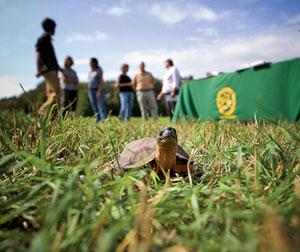By Caroline J. Hanna
 A special guest at the press conference |
Spotting the brownish-gray-and-orange shell of the wood turtle in hay fields or along the banks of rivers in Western Massachusetts has become an increasingly rare occurrence. In fact, the Massachusetts Endangered Species Act recognizes these turtles as a “species of special concern.”
That’s why the college made an agreement with farmers leasing Amherst property to delay mowing a strip of land along a small waterway this summer and fall. The measure—which created a safe habitat for the turtles to live and forage for food—might have spared a significant number of the unhurried creatures from premature deaths.
State and federal agencies held a press conference at Amherst in September to recognize this effort by the college and the farmers.
Of the 1,000 acres of land in Amherst that the college owns, about 800 are undeveloped because of conservation restrictions, agricultural development or, simply, a commitment to keep them green. Many of these acres are wildlife habitats for other animals, such as songbirds.
Wood turtles live throughout New England on the banks of streams, especially slower moving, mid-sized streams with sandy bottoms and heavily vegetated banks. Active from mid-March through October, the animals spend most of the spring and summer in fields, wet meadows, bogs and beaver ponds and then return to the streams for the colder months. It is in the fields and beyond that many turtles are killed by lawn mowers, pollution, cars and pets.
Photo Samuel Masinter '04